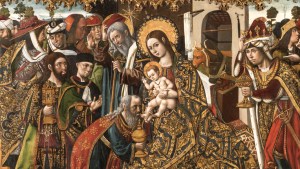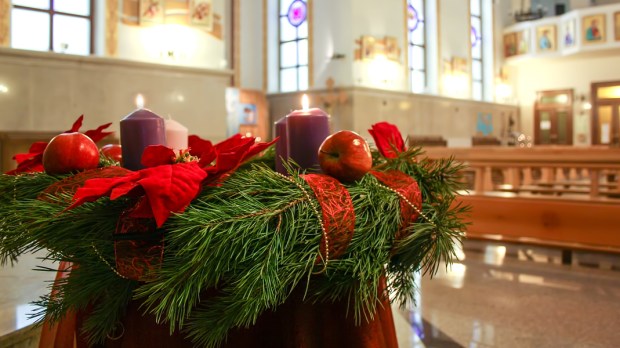This coming weekend beings with two big liturgical celebrations – the Solemnity of the Immaculate Conception on Saturday, December 8, and the Second Sunday of Advent on Sunday, December 9. Most of the time, when holy days of obligation fall the day before a Sunday, the obligation is waived. That’s true this year for Catholics is many parts of the world – but not for those in the United States.
Under the title of the Immaculate Conception, Mary is the patroness of the United States, and as a patronal feast, this celebration is obligatory — a holy day of obligation, when Catholics are asked to attend Mass.
But the Sunday obligation is no less binding. Any ordinary Sunday takes precedence over any feast that falls on the same day, except the Solemnities of the Lord. But the Sundays of Advent and Lent (and the day of Easter, which always falls on a Sunday) take preferences, in the ranking of feasts, over all other feasts – that’s how important these days are to our faith life.
So for US Catholics, this weekend brings two opportunities (and obligations) to celebrate the Eucharist. There are many options for fulfilling this dual obligation, but one thing that won’t work is trying to make one Mass satisfy both obligations.
Depending on local parish schedules – this is a good time to check your bulletin or parish webpage! – US Catholics can attend Mass:
- on Friday evening, December 7 – this will be a Vigil Mass for the Solemnity of the Immaculate Conception – and again on Saturday evening, December 8 (the Vigil Mass for the Second Sunday of Advent) or at any Mass on Sunday, December 9 (the Second Sunday of Advent)
- on Saturday, December 8, during the day (for the Solemnity of the Immaculate Conception), and again on Saturday evening, December 8 (the Vigil Mass for the Second Sunday of Advent) or at any Mass on Sunday, December 9 (the Second Sunday of Advent)
These options will allow you to hear the readings, prayers, and hymns particular to both feasts.
If your parish offers limited times for celebrating the holy day of obligation, you may attend one Mass on Saturday evening, December 8, for the Immaculate Conception, and another Mass any time on Sunday, December 9, for the Second Sunday of Advent. You will probably hear the readings, prayers, and hymns for the Second Sunday of Advent at both these Masses, but it will fulfill the obligation.
Usually, to fulfill an obligation, a Mass must have the readings and prayers proper of the feast being celebrated. Hence, for example, a late Saturday wedding Mass would not satisfy the obligation of Sunday. The situation of this weekend is unique.
If you choose this latter option, you might want to read the readings for the Solemnity of the Immaculate Conception, here, and pray a Rosary in honor of Mary’s feast.
A few other things to remember about the Solemnity of the Immaculate Conception:
- Although we hear the Gospel of Mary’s virginal conception of Jesus at the Mass for this feast, the doctrine of the Immaculate Conception refers to Mary’s own conception in her mother’s womb. As a sign of the saving grace Jesus was bringing into the world, Mary was preserved from the stain of original sin (“immaculate” means “without stain”) from the very first moment of her being.
- The doctrine of the Immaculate Conception was infallibly declared by Pope Pius XI in 1854, but the belief that Mary was spared from sin was long held by the Eastern Churches, by Church Fathers, and by many religious, especially the Franciscans.

Read more:
If you want to love Mary more, find her in the Old Testament (this book will guide you)
- Mary is associated with the title of the Immaculate Conception in many apparitions and devotions. When she appeared to St. Juan Diego as Our Lady of Guadalupe, he was on his way home from celebrating Mass for the Feast of the Immaculate Conception, a holy day kept by the Spanish long before it became a universal feast. Appearing to St. Bernadette at Lourdes, Mary identified herself by saying “I am the Immaculate Conception” – a title only recently acknowledged by the pope and one that Bernadette herself would not have recognized.
- In 1847 (before the pope had declared the doctrine to be universal), the Bishops of the United States published a decree, approved by the pope, placing the United States under the patronage of Mary Immaculate. The Basilica of the National Shrine of the Immaculate Conception in Washington, D.C., is dedicated to Mary under this patronal title. It is the largest Catholic church in the United States, and features artwork donated by Catholics in all 50 states.
- Other nations officially dedicated to the Immaculate Conception include Brazil, Korea, the Philippines, and Spain, with many others claiming Mary Immaculate as their unofficial patron.

Read more:
What is a holy day of obligation? When are they?

